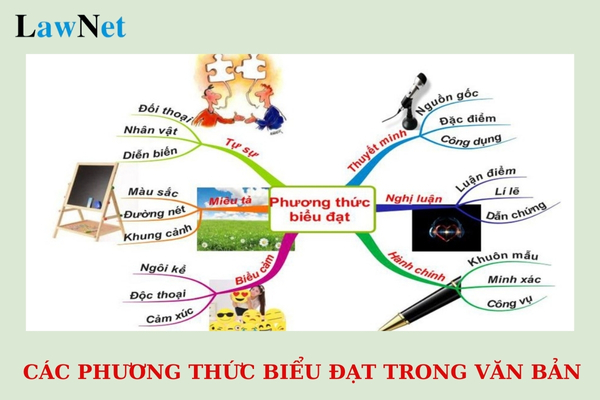How many modes of expression in texts are there? In Vietnam, what is the grade at which students study modes of expression?
How many modes of expression in texts are there in Vietnam?
In texts, there are six main modes of expression:
(1) Narrative: This uses language to tell a series of events, where one event leads to another, concluding with an ending. Moreover, it emphasizes not just telling events but also portraying characters and offering profound and novel insights into human nature and life.
+ Be found in short stories, novels, fables, myths, fairy tales, etc.
(2) Description: This uses language to allow the listener or reader to specifically envisage the object or event as if it appears before their eyes or to recognize the inner world of a person.
+ Be found in poetic and narrative works
(3) Expression: This is a human need in life, as there are always things that move us (feel) and we want to express (express) to one or more people. The expressive mode uses language to reveal one's emotions and feelings about the surrounding world.
+ Be found in genres like poetry, folk songs, diaries, etc. However, diaries often combine narrative and lyricism.
(4) Exposition: This provides, introduces, explains,… knowledge about an object or phenomenon to those who need to know but haven’t known yet.
+ Be found in biographies of a character and knowledge about a scientific issue.
(5) Argumentation: This is mainly used to discuss right or wrong to clearly express the opinion and attitude of the speaker or writer and then to lead and persuade others to agree with their opinion.
+ Be found in argumentative texts discussing to present, comment, and evaluate events, and issues related to politics, society, culture, ideology, etc.
(6) Administrative – Official: This mode is used for communication between the State and the people, between people and State agencies, between agencies, and between countries on a legal basis (circulars, decrees, applications, reports, invoices, contracts...)
+ Be found in documents like Circulars, Decrees, applications, reports, invoices, contracts...
Note: The content is for reference only!

How many modes of expression in texts are there? In Vietnam, what is the grade at which students study modes of expression? (Image from the Internet)
In Vietnam, what is the grade at which students study modes of expression?
Under Section IV of the General Education Program for Literature issued together with Circular 32/2018/TT-BGDDT, the language competencies required at the lower secondary level are as follows:
- Apply knowledge of Vietnamese along with personal experiences and reasoning abilities to understand the text; know how to read the text according to its style and type; understand both explicit and implicit content of the text.
- Recognize and initially be able to analyze and evaluate the content and prominent characteristics of the text’s expression mode; compare a text with another text, relate it to personal life experiences; from there, have personal perspectives, thoughts, and perceptions about life, enriching their spiritual life.
- In grades 6 and 7: be able to write narrative, descriptive, and expressive essays; initially know how to write argumentative, expository, and pragmatic essays.
- In grades 8 and 9: be able to write complete narrative, argumentative, and expository essays, following the correct steps and integrating modes of expression.
Under the above regulations, students begin to study modes of expression in the 6th-grade Literature curriculum, including narrative, description, and expression and initially know how to write argumentative, expository, and pragmatic essays.
What are the educational objectives of Literature at the lower secondary level in Vietnam?
Under Section III of the General Education Program for Literature issued together with Circular 32/2018/TT-BGDDT, the educational objectives of Literature at the lower secondary level in Vietnam are as follows:
- Help students continue to develop the good qualities formed in primary school; enhance and broaden the development requirements for qualities with specific manifestations such as being proud of the national history and literature; having dreams and aspirations, a spirit of self-learning and self-respect, civic consciousness, and respect for the law.
- Continue to develop general competencies, language competence, and literary competence formed in primary school with higher achievement requirements; develop language competence with requirements:
+ Differentiate literary texts, argumentative texts, and informational texts; comprehend both explicit and implicit content of various types of texts;
+ Write coherent, logical, and process-correct narrative, descriptive, expressive, argumentative, expository, and pragmatic paragraphs and essays, combining expression modes; speak clearly and coherently;
+ Have a confident attitude suitable for the communication context; understand listening with an appropriate attitude.
- Develop literary competence with requirements:
+ Differentiate between story genres, poetry, diary, drama, and some specific subgenres; recognize the characteristics of literary language, recognize, and analyze the effects of elements and artistic measures associated with each literary genre;
+ Recognize expressive value, cognitive value, and aesthetic value; analyze imagery, content, and form of literary works; be able to create some products of literary nature.

